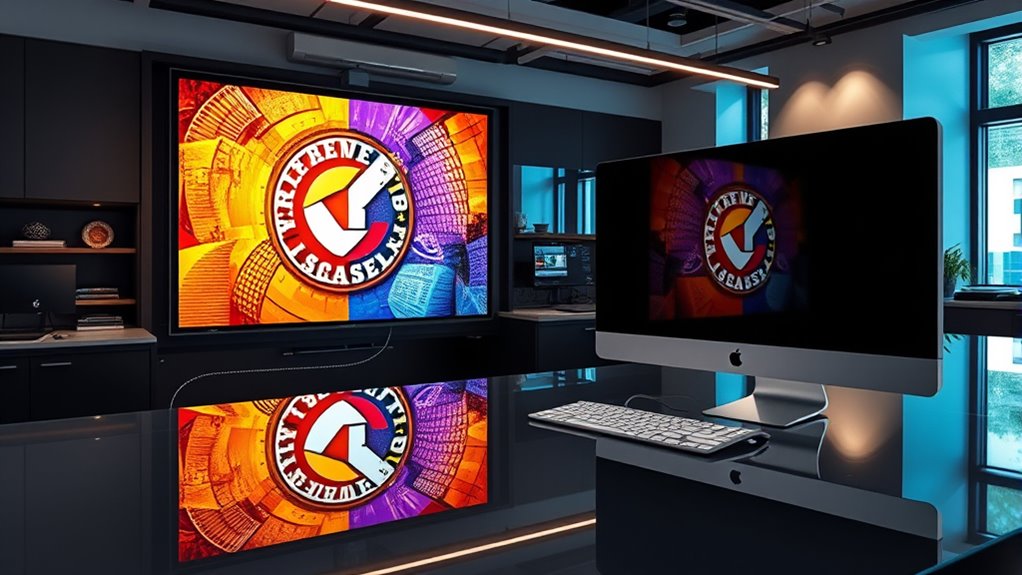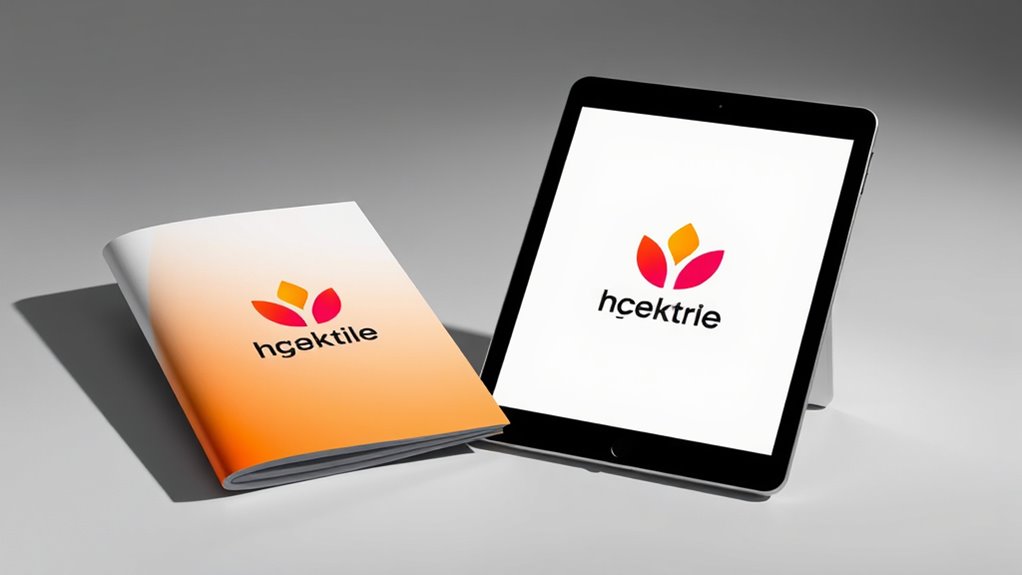To guarantee consistency in cross-media branding from print to digital, you should develop clear brand guidelines that specify logo usage, colors, fonts, and imagery. Use digital tools and regular audits to keep your visual identity uniform across all platforms. This builds recognition, trust, and loyalty by creating a cohesive experience. Maintaining this consistency makes your brand more memorable and trustworthy—if you want to find out how to master this, you’ll discover key strategies below.
Key Takeaways
- Develop comprehensive brand guidelines to standardize logo, color, typography, and imagery across all media platforms.
- Utilize digital tools and asset libraries for consistent content creation and easy access to branding elements.
- Regularly audit branding materials to ensure uniformity and update them to reflect evolving trends and regional preferences.
- Maintain consistent visual identity by applying the same design standards to print, digital, social media, and advertising channels.
- Reinforce brand message and personality at every touchpoint to build trust, recognition, and audience loyalty across media formats.

Cross-media branding is a powerful strategy that allows your brand to reach audiences across multiple platforms seamlessly. When you focus on creating a consistent visual identity, you guarantee that your brand remains recognizable no matter where your audience encounters it. A strong visual identity acts as the backbone of your cross-media efforts, tying together your print materials, digital content, social media, and other channels. When your visual elements—such as logos, color schemes, typography, and imagery—align across platforms, it reinforces your brand recognition, making it easier for people to identify and remember your brand quickly.
Consistency is key in maintaining a cohesive look and feel, which helps build trust and familiarity among your target audience. When your branding appears uniform across your website, social media profiles, packaging, and advertising, it sends a clear message that your brand is reliable and professional. This uniformity also boosts brand recognition, as consumers start associating specific visual cues with your business. Over time, this recognition turns into loyalty, giving you a competitive edge in crowded markets.
Consistent branding builds trust, recognition, and loyalty across all your platforms.
To achieve this, you need to develop detailed brand guidelines that specify how your visual identity should be applied across all mediums. These guidelines serve as a blueprint, detailing everything from logo placement and color palettes to font choices and imagery style. Implementing these rules helps guarantee that whether someone sees your billboard, a social media post, or a business card, they receive a consistent visual experience. As a result, your brand’s personality and message are reinforced at every touchpoint, making your cross-media branding efforts more effective.
In addition, leveraging digital tools and templates can streamline this process. Using design software and brand asset libraries, you can quickly produce content that adheres to your visual standards. This not only saves time but also reduces the risk of inconsistent brand representations. Moreover, regularly auditing your branding materials across channels ensures that your visual identity remains uniform and relevant, especially as trends evolve. Understanding local laws and regional preferences can also help tailor your branding strategies to specific markets, enhancing effectiveness.
Ultimately, your goal with cross-media branding is to create a unified and recognizable presence that resonates with your audience. When your visual identity is consistent, people don’t have to decipher who you are; they immediately recognize your brand. This recognition encourages engagement, builds loyalty, and helps your brand stand out in a competitive landscape. By prioritizing consistency and clarity in your visual identity, you lay the foundation for a powerful, enduring brand that connects deeply with your audience across all platforms.
Frequently Asked Questions
How Do I Measure Cross-Media Branding Effectiveness?
You can measure cross-media branding effectiveness by tracking engagement metrics like click-through rates, social shares, and time spent on content across platforms. Additionally, monitor changes in brand perception through surveys or sentiment analysis. Comparing these metrics over time helps you see if your consistent branding boosts recognition and trust. Ultimately, these insights reveal how well your message resonates and if your cross-media efforts strengthen your brand identity.
What Tools Assist in Maintaining Brand Consistency Across Platforms?
You can use tools like Canva, Adobe Creative Cloud, and Brandfolder to maintain brand consistency across platforms. These tools help you manage your visual style and color palette, ensuring your branding stays uniform whether in print or digital. Additionally, brand guidelines and digital asset management systems keep everyone on the same page, so your visual identity remains cohesive and recognizable across all media.
How Often Should Branding Elements Be Updated for Digital?
You should update branding elements every 12 to 24 months to stay fresh and relevant. Regular visual updates and a strategic brand refresh help maintain consistency across digital platforms. Keep an eye on industry trends and audience feedback, and adapt your visuals accordingly. This proactive approach ensures your brand remains engaging and cohesive, fostering trust and recognition while preventing your digital presence from feeling outdated or inconsistent.
How to Handle Brand Inconsistencies Across Media?
To handle brand inconsistencies across media, you should regularly review your brand voice and visual identity. Create thorough brand guidelines and guarantee everyone understands and follows them. Conduct periodic audits across platforms to spot discrepancies. When inconsistencies arise, update your assets promptly and communicate changes clearly. Consistent messaging and visuals reinforce your brand’s integrity, so stay proactive in maintaining alignment across all digital and print channels.
What Are Common Mistakes in Cross-Media Branding?
A common mistake in cross-media branding is neglecting to uphold a consistent brand style and visual identity across platforms. You might inadvertently use different colors, fonts, or logos, which confuses your audience. Another mistake is failing to adapt your visuals appropriately for each medium, causing inconsistency. Always review your brand style guide and ensure your visual identity remains cohesive, regardless of whether you’re in print or digital.
Conclusion
By maintaining consistency across print and digital platforms, you create a unified brand experience that’s as powerful as a thunderclap. When your visuals, messaging, and tone align seamlessly, you build trust and recognition that’s impossible to ignore. Remember, in the domain of cross-media branding, perfection isn’t just a goal—it’s your secret weapon to outshine competitors and leave an indelible mark on your audience’s mind. Embrace the challenge, and watch your brand soar beyond expectations.









